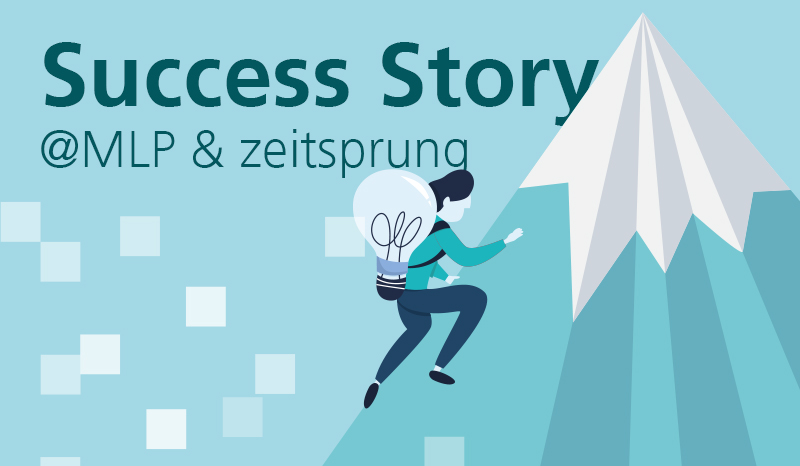The goals in a financial company can be very different: Growth in existing business areas, the development of new markets, more customer loyalty or securing service capacities in and outside the own company. But which goal has not yet been mentioned at this point? The goal: digitization! And fast - the Corona crisis takes no account of the analog world.
MLP - the interlocutor in all financial matters, from wealth management and retirement planning to insurance. How can one imagine the communication of such a large corporation with its customers and the many different insurance companies and other external service providers? A mountain of mail that was almost impossible to climb. You might think that was a thing of the past, but it wasn't that long ago when checking and distributing incoming mail was a full-time job at MLP for many employees. But as early as 2007, MLP began implementing the first individual document interfaces with the largest insurers - earlier than any other broker. A year later, more than 100,000 documents were already being processed. Soon after, MLP started to get involved with the industry initiative BiPRO e.V. and was a welcome pilot partner for many insurers. But there were a great many insurers who, despite advanced digitization capabilities, provided neither standardized nor customized interfaces. These insurers still only had paper mail or highly customized online portals for manual individual download of broker mail. This self-service was, of course, far too costly for larger brokers. It simply took too long to "surf" all the companies' portals on a daily basis. Lengthy login processes with individual access data were followed by manual downloading of documents and subsequent manual distribution to customer files. Despite all efforts, the interface connections faltered in the long term, as the insurers were often unable to implement the requirements.
At this point a time jump should now happen - yes exactly, because time jump is the digitalization engine of the insurance industry and the minds of the software developers are full of visions for the digital future of this branch of industry. For example, zeitsprung's document service was able to retrieve the online portals provided by the insurance companies independently and fully automated. This made it possible to provide the agent mail of many other insurers digitally and automatically. In addition to these individual services, it was also possible to use the standardized BiPRO interfaces of the insurers. The documents loaded in this way were made available in a standardized mailbox, i.e. the receipt and automated further processing of electronic documents from the insurers was thus possible. According to the BiPRO standard, today even more than 90 insurance companies are integrated into the document service - the number is still growing steadily. But zeitsprung can also process other document sources automatically.
To ensure that the responsible employee receives the day's mail without manual intervention, web services and robotics services that retrieve extranets run in the background. The data, including meta information, is then consolidated in a central mailbox, where it is automatically distributed via an intelligent set of rules. In order for the documents to be correctly assigned to a specific customer and/or insurance contract, for example, the data from the insurers must have a certain quality of meta information. If they do not meet this required standard, zeitsprung's document service is able to use artificial intelligence to enrich the metadata in such a way that an efficient process flow is still guaranteed and no manual assistance is required for distribution. Document content can also be evaluated from PDF image files using complex OCR technology and made available as extracted metadata.
Filtering and rules are further product components that the document service offers in terms of process acceleration. The option of setting individual filters allows users to determine exactly which mail they want to receive and which they do not. This means that incoming mail no longer has to be cleared of unimportant information, which saves time and therefore money. The rule control, on the other hand, can be used by the user to expand his digital document inbox with additional company-specific follow-up processes. For example, documents from different companies, divisions or business transactions can be processed in a differentiated manner, document names can be assigned, and metadata can be added or corrected in a targeted manner so that they can be processed further within the company in subsequent processes. Due to the high degree of individuality, the application diversity of rules is enormous. In the meantime, a competent community has formed, which is moderated by zeitsprung employees. Concentrated knowledge of rules and filters that have already been tested in practice are thus available and can be viewed and used in a targeted manner via a central community app.
Since MLP started using zeitsprung's document service, a lot has changed. Manuel Schmalz, Head of Portfolio and Commission at MLP, summarizes: "The result of the cooperation with zeitsprung is that agent mail can be processed largely digitally and fully automated into the end systems. The physical receipt of paper documents in the insurance industry is at a historic minimum level thanks to the joint efforts. We now receive only three percent of our intermediary mail from insurance companies on paper; the rest is processed digitally in a unified and accelerated process. This reduces costs and returns precious time in the broker's daily routine ."

